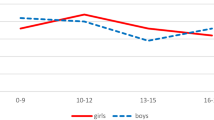Abstract
This study investigated the relationship between presenting complaints and prior mental health encounters in youth seen for emergency psychiatric consultation. Records of youths aged 9–17 years old receiving a psychiatric consultation in a pediatric emergency department from 2002 to 2007 were examined (N = 1,900). Youth were classified by presenting complaint: suicide attempt, suicidal ideation, and behavioral problems. Nearly half of the youth presented with behavior problems, and 39% presented with suicidal ideation and/or attempt. Those presenting with both suicide attempt and behavior problems were most likely to have made a prior suicide attempt. Those presenting with suicide attempt alone were least likely to report current mental health treatment, while youth presenting with behavior problems alone were the most likely to report current mental health treatment. Further research is needed to better understand the role that emergency departments play in the course of care and to maximize the opportunity to make lasting and effective community-based care connections.
Similar content being viewed by others
References
Burks HL, Hoekstra M. Psychiatric emergencies in children. American Journal of Orthopsychiatry. 1964;34:134–137.
Edelsohn GA, Braitman LE, Rabinovich H, et al. Predictors of urgency in a pediatric psychiatric emergency service. Journal of the American Academy of Child and Adolescent Psychiatry. 2003;42:1197–1202.
Mattsson A, Hawkins JW, Seese LR. Child psychiatric emergencies: clinical characteristics and follow-up results. Archives of General Psychiatry. 1967;17:584–592.
Morrison GC. Therapeutic intervention in a child psychiatry emergency service. Journal of the American Academy of Child Psychiatry. 1969;8:542–558.
Breslow RE, Erickson BJ, Cavanaugh KC. The psychiatric emergency service: where we've been and where we're going. Psychiatric Quarterly. 2000;71:101–121.
Haugh R. A crisis in adolescent psychiatry. Hospital Health Network. 2003;77:12.
Page D. Pediatric psychiatry: more blues in ED? Hospital Health Network. 2000;74:24.
Sills MR, Bland SD. Summary statistics for pediatric psychiatric visits to US emergency departments, 1993-1999. Pediatrics. 2002;110:1–5.
Christodulu KV, Lichenstein R, Weist MD, et al. Psychiatric emergencies in children. Pediatric Emergency Care. 2002;18:268–270.
Hoyle JD, White LJ. Pediatric mental health emergencies: summary of a multidisciplinary panel. Prehospital Emergency Care. 2003;7:60–65.
Hoyle JD, White LJ. Treatment of pediatric and adolescent mental health emergencies in the United States: current practices, models, barriers, and potential solutions. Prehospital Emergency Care. 2003;7:66–73.
Asarnow JR, Baraff LJ, Berk M, et al. Pediatric emergency department suicidal patients: two-site evaluation of suicide ideators, single attempters, and repeat attempters. Journal of the American Academy of Child and Adolescent Psychiatry. 2008;47(8):958–966.
Santiago LI, Tunik MG, Foltin GL, et al. Children requiring psychiatric consultation in the pediatric emergency department: epidemiology, resource utilization, and complications. Pediatric Emergency Care. 2006;22(2):85–89.
Behar LJ, Shrier DK. Child and adolescent psychiatric emergencies: referral and discharge patterns. New Jersey Medicine. 1995;92:236–239.
Goldstein AB, Horwitz SM. Child and adolescent psychiatric emergencies in nonsuicide-specific samples: the state of the research literature. Pediatric Emergency Care. 2006;22:379–384.
Suominen K, Isometsa E, Martunnen M, et al. J. Health care contacts before and after attempted suicide among adolescent and young adult versus older suicide attempters. Psychological Medicine. 2004;34(2):313–321.
Litt IF, Cuskey WR, Rudd S. Emergency room evaluation of the adolescent who attempts suicide: compliance with follow-up. Journal of Adolescent Health Care. 1983;4(2):106–108.
Rotheram-Borus MJ, Piacentini J, Miller S, et al. Toward improving treatment adherence among adolescent suicide attempters. Clinical Child Psychology and Psychiatry. 1996;1(1):99–108.
Rotheram-Borus MJ, Piacentini J, Van Rossem R, et al. Enhancing treatment adherence with a specialized emergency room program for adolescent suicide attempters. Journal of the American Academy of Child & Adolescent Psychiatry. 1996;35(5):654–663.
Spirito A, Boergers J, Donaldson D. Adolescent suicide attempters: post-attempt course and implications for treatment. Clinical Psychology and Psychotherapy. 2000;7:161–173.
Spirito A, Boergers J, Donaldson D, et al. An intervention trial to improve adherence to community treatment by adolescents after a suicide attempt. Journal of the American Academy of Child & Adolescent Psychiatry. 2002;41(4):435–442.
Spirito A, Lewander W. Assessment and disposition planning for adolescent suicide attempters treated in the emergency department. Clinical Pediatric Emergency Medicine. 2004;5(3):154–163.
Granboulan V, Roudot-Thoraval F, Lemerle S, et al. Predictive factors of post-discharge follow-up care among adolescent suicide attempters. Acta Psychiatr Scandanavia. 2001;104(1):31–36.
Grupp-Phelan J, Harman JS, Kelleher KJ. Trends in mental health and chronic condition visits by children presenting for care at U.S. emergency departments. Public Health Reports. 2007;122(1)55–61.
Lewinsohn PM, Rohde P, Seeley JR. Adolescent suicidal ideation and attempts: prevalence, risk factors, and clinical implications. Clinical Psychology: Science and Practice. 1996;3(1):25–46.
Reinherz HZ, Giaconia RM, Silverman AB, et al. Early psychosocial risks for adolescent suicidal ideation and attempts. Journal of the American Academy of Child and Adolescent Psychiatry. 1995;34(5):599–611.
Acknowledgments
The authors would like to express their gratitude to Christine Cary, Janet Kowalski, Sarah Lusk, and Kate Maloney for their assistance on this project and preparation of this manuscript.
Author information
Authors and Affiliations
Corresponding author
Rights and permissions
About this article
Cite this article
Frosch, E., McCulloch, J., Yoon, Y. et al. Pediatric Emergency Consultations: Prior Mental Health Service Use in Suicide Attempters. J Behav Health Serv Res 38, 68–79 (2011). https://doi.org/10.1007/s11414-009-9192-0
Received:
Accepted:
Published:
Issue Date:
DOI: https://doi.org/10.1007/s11414-009-9192-0



